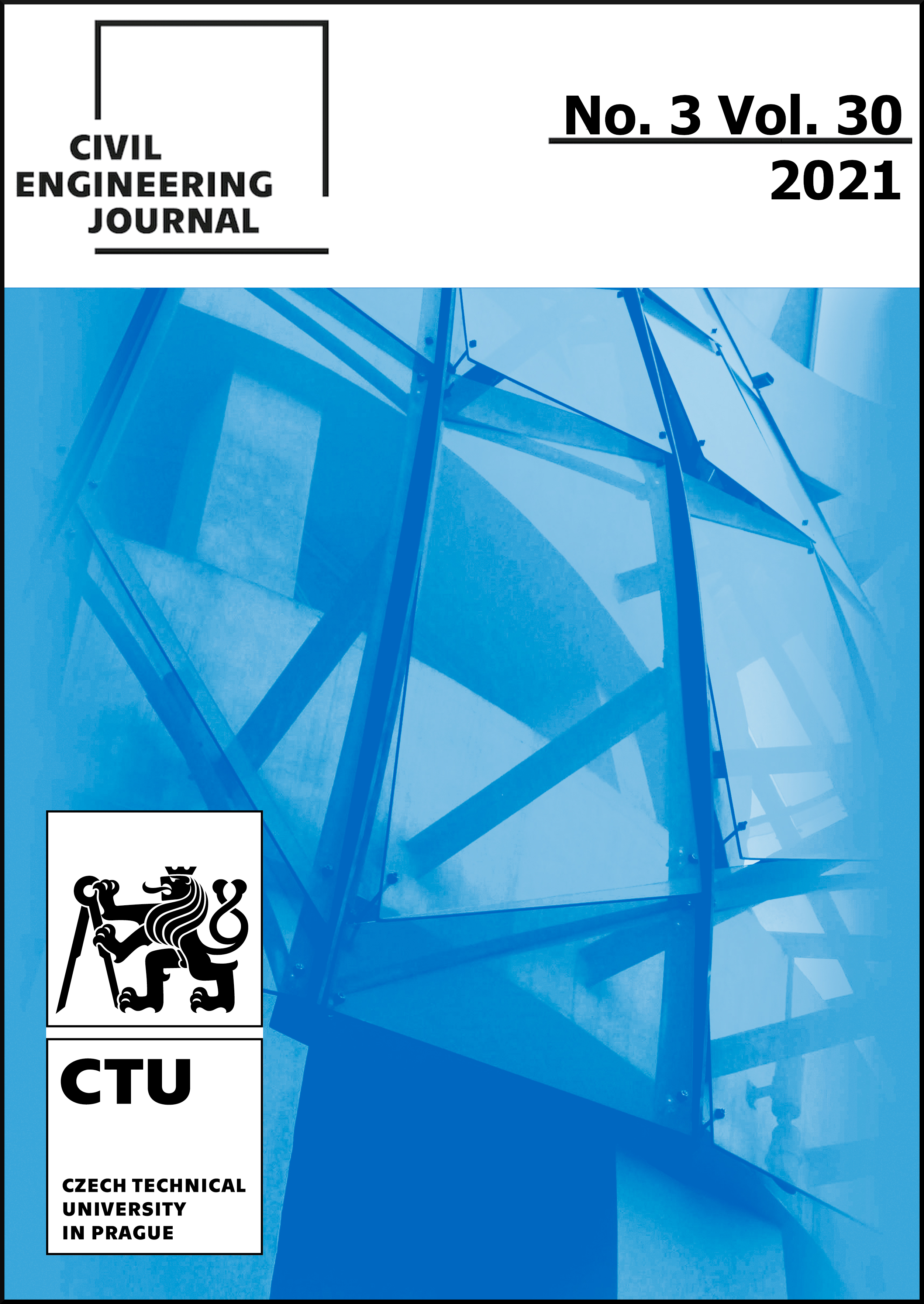STUDY ON SPATIAL STRESS EFFECT OF PC CONTINUOUS THIN-WALLED BOX GIRDER BRIDGE
DOI:
https://doi.org/10.14311/CEJ.2021.03.0048Keywords:
thin-walled box girder bridge; spatial stress effect; shear lag effect; load testAbstract
In order to study the influence of spatial stress effect and shear lag effect on the cracking of PC continuous thin-walled box girder bridge, a spatial model was established by using ANSYS finite element software to analyze the internal stress distribution of the bridge. The test results are compared with the analysis results of spatial model and plane link system model through the load test of real bridge. The results show that the longitudinal stress is evenly distributed along the width direction, which means that the spatial stress effect and the shear lag effect have little influence on the downdeflection of the bridge. The shear lag coefficient at the longitudinal axis of midspan bottom plate and the intersection of bottom plate and web are larger than other positions, which is most likely to produce cracks caused by stress concentration, and should be strengthened here in practical engineering. The results of load test show that the results of spatial finite element analysis are more reliable than those of plane link system calculation, and the design and construction based on the results of spatial finite element analysis is safer.
Downloads
References
Guo JM. Design Theory of Box Girder[M]. Beijing: China Communications Press, 1999.
Peng W, Xing HY, Ke SG. Study on Cracking Control of PC Continuous Box Girder Bridges[J]. Journal of Zhejiang Universitr of Technology, 2003, 31(1): 22-27.
Li Z, Nie JG, Ji WY. Positive and Negative Shear Lag Behaviors of Composite Twin-Girder Decks with Varying Cross-Section[J]. Science China Technological Sciences, 2017, 60(1): 116-132.
Lin PZ, Liu FK, Ji W, et al. Analysis on Shear Lag Effect of Concrete Box Beam by Variation Principle[J]. Journal of The China Railway Society, 2013, 35(2): 93-98.
Guo ZW, Li LJ, Zhang JB. Theoretical Analysis for Shear-lag Effect of Variable Box Section Cantilever Girder Based on Bar Simulation Method[J]. China Civil Engineering Journal, 2019, 52(8): 72-80.
Cambronero-Barrientos F, Díaz-Del-Valle J, Martínez-Martínez JA. Beam Element for Thin-Walled Beams with Torsion, Distortion and Shear Lag[J]. Engineering Structures, 2017, 143: 571-588.
Ma C, Liu SZ, Wu MQ. Matrix Analysis of Composite Box Girder with Corrugated Steel Webs Considering Shear Deformation and Shear Lag Effect[J]. China Journal of Highway and Transport, 2018, 31(3): 80-88.
Feng HY. The Analysis of Space Stress and Shear Lag Effect of Prestressed Concrete Thin-Walled Box Girder Bridge[D]. Harbin: Northeast Forestry University, 2011.
Zhao H, Gou HY, Ni YS. Shear Lag Effect of Corrugated Steel-Concrete Composite Multi-Box Cable-Stayed Bridge[J]. Journal of South China University of Technology(Natural Science Edition), 2020, 48(7): 93-103.
Xu D, Ni YS, Zhao Y. Analysis Corrugated Steel Web Beam Bridges Using Spatial Grid Modeling[J]. Steel and Composite Structures, 2015, 18(4): 853- 871.
Razaqpur AG, Li HG. Thin-Walled Multicell Box-Girder Finite Element[J]. Journal of Structural Engineering, 1991(10): 2953-2971.
Lin PZ,Sun LX,Yang ZJ, et al. Research on Shear Lag Effect of Twin-Cell Box Girders[J]. Journal of Railway Engineering Society, 2014(1): 59-60.
CCCC Highway Consultants Co., Ltd, Specifications for Design of Reinforced Concrete and Prestressed Concrete Highway Bridges and Culver(JTJ 023-85)[M]. Beijing: China Communications Press, 1985.
Karman TV. Die Mittragende Breite, Beitrage Zur Technischen Mechanik Undechnischen Physic[M]. Berlin: August Foppl Festschrift, Julius Springer, 1924.
Duan HJ, Zhao RD. Segment Element of Thin-Walled Curved Box Girder by Spatial Analysis[J]. China Civil Engineering Journal, 2004, 37(12): 1-5.
Downloads
Published
Issue
Section
License
Copyright (c) 2021 Stavební obzor - Civil Engineering Journal

This work is licensed under a Creative Commons Attribution-NonCommercial 4.0 International License.
Authors who publish with this journal agree to the following terms:
- Authors retain copyright and grant the journal right of first publication with the work simultaneously licensed under a Creative Commons Attribution License that allows others to share the work with an acknowledgement of the work's authorship and initial publication in this journal.
- Authors are able to enter into separate, additional contractual arrangements for the non-exclusive distribution of the journal's published version of the work (e.g., post it to an institutional repository or publish it in a book), with an acknowledgement of its initial publication in this journal.
- Authors are permitted and encouraged to post their work online (e.g., in institutional repositories or on their website) prior to and during the submission process, as it can lead to productive exchanges, as well as earlier and greater citation of published work (See The Effect of Open Access).
How to Cite
Accepted 2021-05-25
Published 2021-10-25










